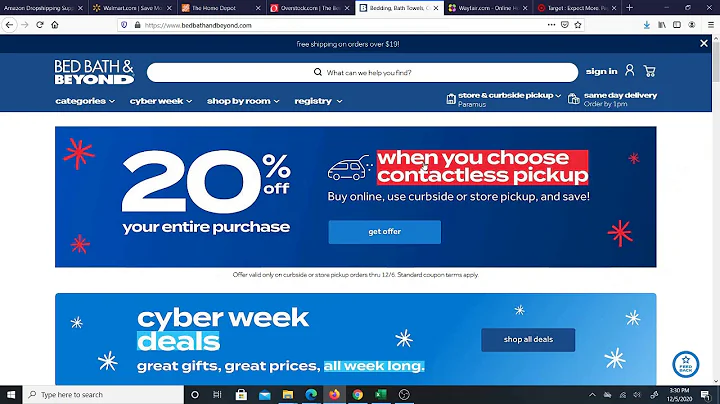Achieving Success in Print On Demand on Etsy
Table of Contents:
- Introduction
- Market Research on Etsy
- Creating Professional Listing Templates
- Switching to Printify Premium
- Listing Consistently on Etsy
- Utilizing Etsy Ads
- Results of One Month: Visits, Orders, and Revenue
- Analyzing Profit Margins and Making Adjustments
- Future Plans: Switching Targeted Niche and Products
- Conclusion
Introduction
In this article, we will discuss the journey of starting a print-on-demand store on Etsy and the strategies implemented to achieve success. We will explore the importance of market research, creating professional listing templates, utilizing print-on-demand platforms like Printify, listing consistently on Etsy, and leveraging Etsy ads. Additionally, we will analyze the results obtained in the first month and discuss future plans for growth and profitability.
Market Research on Etsy
One of the key factors in the success of the print-on-demand store was thorough market research, particularly focusing on the Etsy marketplace. By utilizing a Chrome extension called Everbee, important statistics about monthly sales and revenue of Etsy listings were gathered. This helped in identifying popular categories, niches, and search terms that were trending on Etsy. By analyzing the attributes of top-selling products and stores, such as design types, color schemes, images, titles, and tags, valuable insights were obtained. This market research approach ensured a targeted and informed strategy towards product selection and listing optimization.
Creating Professional Listing Templates
To streamline the process of listing products on Etsy, professional listing templates were created using platforms like Printify and Canva. This saved a significant amount of time and ensured consistent and professional-looking product images. Canva was used to create mock images with predefined spaces for designs, allowing for easy customization and quick placement of designs. Printify, on the other hand, offered listing templates for different types of products, such as shirts, crewnecks, and hoodies. These templates eliminated the need to rewrite descriptions and adjust prices for each design, making the listing process more efficient.
Switching to Printify Premium
To improve profit margins, the decision was made to switch to Printify Premium. This allowed for increased profits per product sold without raising the selling prices. In comparison to the previous profit margins of around $2 or $3, Printify Premium elevated the profit margins to approximately $6 or $7 per product sold. The flexibility offered by Printify, especially in choosing the fulfillment center location, also helped in saving shipping costs for international sales. The overall experience with Printify as a fulfillment company was highly positive, contributing to the success of the print-on-demand store.
Listing Consistently on Etsy
To demonstrate store activity and gain visibility in Etsy's algorithm, the goal was to post at least one new design per day consistently. This proactive approach aimed to show Etsy that the store was actively engaged with a wide variety of products. The more designs posted, the higher the chances of potential customers stumbling upon them. By increasing the number of listings and continually adding new products, the store aimed to increase the likelihood of making consistent sales.
Utilizing Etsy Ads
To further enhance the visibility of products and drive sales, Etsy ads were utilized. Etsy ads operate on a cost-per-click model, ensuring that payment is only made when someone clicks on the product listing. The ad budget was maximized to increase exposure. However, despite an initial spike in ad spend to $13 per day, the average ad spend remained around $2 or $3 per day. Efforts are ongoing to optimize Etsy ads and achieve better results in terms of sales and revenue. The goal is to improve product rankings on Etsy and secure a prominent position on the first page of search results.
Results of One Month: Visits, Orders, and Revenue
In the first month of operation, the print-on-demand store generated a total of 439 visits, resulting in nine orders and $323.03 in revenue. It is important to note that these results exclude the impact of Etsy ads. A separate analysis was conducted to evaluate the performance of Etsy ads, which resulted in over 24,000 views, 298 clicks, and five orders. The total revenue from Etsy ads amounted to $177.72, with an ad spend of $101.89. Although the profit margin initially seemed underwhelming at $2.77, it is important to acknowledge that building a successful business takes time and effort.
Analyzing Profit Margins and Making Adjustments
Upon reviewing the numbers, it was discovered that the profit margin for t-shirts was extremely low. To address this, an adjustment was made to increase the selling price, ensuring a more favorable profit margin. This serves as a valuable lesson in continuously analyzing and optimizing the pricing strategy to achieve profitability. The focus on improving profit margins will be an ongoing priority, and adjustments will be made accordingly.
Future Plans: Switching Targeted Niche and Products
To expand the market reach and increase sales potential, future plans involve switching the targeted niche from mom products to larger group-focused categories such as bachelor parties, bachelorette parties, or birthday parties. By exploring new avenues and diversifying product offerings, the aim is to generate multiple sales per order, ultimately driving higher sales volumes. While apparel remains a preferred product category, there will be a deliberate shift in design themes to cater to different occasions and customer preferences.
Conclusion
The first month of operating a print-on-demand store on Etsy has shown promising results and valuable insights. Through extensive market research, the store was able to identify trending niches and optimize product listings accordingly. Utilizing professional listing templates and leveraging print-on-demand platforms like Printify has streamlined operations and increased profitability. Listing consistently and utilizing Etsy ads have contributed to generating traffic and sales. By analyzing profit margins and making necessary adjustments, the store aims to achieve sustainable growth and profitability. The future plans involve exploring new niches, introducing diverse products, and continuously refining the strategies to capitalize on opportunities in the print-on-demand market.
Highlights:
- Thorough market research on Etsy niches for targeted product selection.
- Creation of professional listing templates for efficient product listing.
- Switching to Printify Premium to improve profit margins.
- Consistent listing to demonstrate store activity and increase sales opportunities.
- Utilizing Etsy ads to enhance product visibility and drive sales.
- Results: 439 visits, 9 orders, and $323.03 revenue in the first month.
- Analyzing profit margins and adjusting pricing strategy for better profitability.
- Future plans include switching niches and expanding product offerings.
FAQ:
Q: How did market research contribute to the store's success?
A: Thorough market research helped identify trending niches and optimize product listings based on popular categories and search terms. By understanding customer preferences and leveraging this information, the store achieved higher interest and sales.
Q: How did utilizing professional listing templates streamline operations?
A: Creating professional listing templates saved time and ensured consistent and professional-looking product images. This allowed for quick customization and placement of designs, resulting in efficient product listing on Etsy.
Q: What were the results obtained in the first month of operation?
A: In the first month, the store received 439 visits, obtained nine orders, and generated $323.03 in revenue. These results were achieved without considering the impact of Etsy ads.
Q: How were profit margins optimized?
A: Upon evaluating profit margins, adjustments were made to increase the selling price of certain products. By carefully analyzing the pricing strategy, the store aimed to improve profit margins and achieve better profitability.
Q: What are the future plans for growth and expansion?
A: The store plans to switch to a new targeted niche, focusing on larger group categories such as bachelor parties or birthday parties. Diversifying product offerings and continually refining strategies will drive growth and increase sales potential.



















